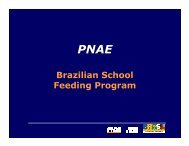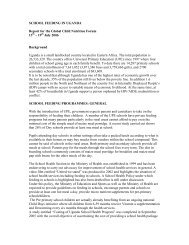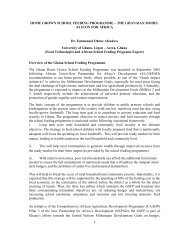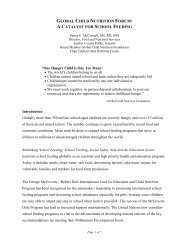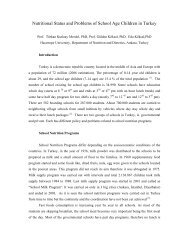EXECUTIVE SUMMARY - Global Child Nutrition Foundation
EXECUTIVE SUMMARY - Global Child Nutrition Foundation
EXECUTIVE SUMMARY - Global Child Nutrition Foundation
You also want an ePaper? Increase the reach of your titles
YUMPU automatically turns print PDFs into web optimized ePapers that Google loves.
Scaling Up Sustainability: Linking School Feeding with Agriculture<br />
Development to Maximize Food Security<br />
May 3-7, 2011<br />
Nairobi, Kenya<br />
Agriculture and <strong>Nutrition</strong> Linkages<br />
■ Speakers: Arvind Kumar (Chair), Government of India<br />
Valeria Menza, Food and Agriculture Organization of The United Nations (FAO)<br />
Martin Kabaluapa, Purchase for Progress, The United Nations World Food Programme (WFP)<br />
Overview<br />
Two UN organizations are tackling the issue of school feeding<br />
and nutrition from different perspectives. The FAO is developing<br />
curricular programs that encourage the use of school gardens as<br />
learning laboratories, not production facilities. P4P is helping<br />
confederations of smallholder farmers to streamline and stabilize<br />
the procurement of school meals.<br />
Context<br />
Ms. Menza discussed what the FAO has learned about the<br />
appropriate role for school gardens, and Mr. Kabaluapa described a<br />
large African pilot program to optimize school food procurement<br />
from smallholder farmers.<br />
Key Points<br />
Schools are a key for nutrition assistance and education.<br />
A school meal program can be about much more than simply<br />
providing nutritious food for children, as critical as that is. It is<br />
also potentially a way to:<br />
Instill lifelong habits. At a young age, children can be<br />
introduced to specific personal hygiene, food safety, and<br />
nutritional diversity practices.<br />
Impart knowledge and skills. Particularly in “garden-based<br />
learning,” students have the opportunity to acquire and<br />
practice small-scale agriculture competencies.<br />
Reach the community at large. <strong>Child</strong>ren are the most direct<br />
route to educating families and the wider community about<br />
food safety, nutrition, and security issues. Homework<br />
assignments can be used to engage parents in food issues.<br />
Impact future economic and nutritional health. If students are<br />
better nourished, they learn better in the classroom, improve<br />
their attendance and retention, obtain better jobs that pay<br />
more, and improve their lifelong diets.<br />
Connect with other programs. School feeding programs can<br />
link with ongoing programs such as growth monitoring to<br />
provide a fuller picture of local community health.<br />
“Good program design ensures the long-term<br />
objective that school feeding programs improve<br />
both child and family nutrition and food security.”<br />
Valeria Menza, FAO<br />
The FAO, founded 65 years ago and best known for its<br />
agriculture programs, is focusing on raising the nutrition levels of<br />
the entire population. The organization has active partnerships<br />
with the WFP, the FRESH Initiative, WHO <strong>Global</strong> Strategy,<br />
<strong>Nutrition</strong>-Friendly Schools, and UNESCO. The FAO has also<br />
produced curriculum-planning, teacher-training, and childoriented<br />
guides to school gardens.<br />
© 2011 GCNF and PCD. All rights reserved. Page 18<br />
Under development now, a new FAO Brazil program called<br />
“Connecting Family Agriculture to School Feeding and Food<br />
Assistance” will operate in five African nations.<br />
School gardens are for teaching and learning, not feeding.<br />
Some earlier school gardens encountered abuse, in that the<br />
gardens were put into production mode, not only to supply school<br />
meals, but to sell the excess. <strong>Child</strong>ren were at times forced into<br />
long hours of planting, cultivating, and harvesting, which is a<br />
clear violation of child-labor laws.<br />
Today the FAO’s view is that school gardens should not be<br />
expected to produce all or most of the school’s food or improve<br />
the institution’s nutritional level. Instead, these gardens should be<br />
considered practical laboratories and teaching tools where<br />
students learn about nutrition and gain basic skills.<br />
Thought of this way, “garden-based learning” is one component<br />
in a comprehensive approach that includes school feeding and<br />
nutritional education. The school garden may supply snacks or<br />
parts of meals, but cannot be the primary source of food.<br />
Providing schools with food requires an approach that<br />
engages cooperatives of smallholder farmers.<br />
No matter how local they are, small-scale farms are often not<br />
equipped to provide food directly to schools. They lack<br />
transportation, infrastructure, storage facilities, and market-price<br />
discovery. However, groups of farmers—cooperatives,<br />
confederations, and other networks—can aggregate their<br />
harvests, deal with traders and exchanges, and in doing so<br />
engage the broader food market.<br />
Recognizing this, the WFP has launched a Purchase for<br />
Progress (P4P) pilot program to determine which procurement<br />
approach best supports farmers, and how to balance risks and<br />
costs in optimizing and transforming local procurement practices.<br />
The WFP has identified 960 organizations representing 860,000<br />
farmers and is working with 210 groups. The WFP supplies<br />
infrastructure, quality-control assistance, financial credit,<br />
research, advocacy, and training in management and bestpractice<br />
farming techniques.<br />
To date, P4P has helped source school meals in 21 countries,<br />
where 60% of the food sourced is procured locally. Among the<br />
pilot’s challenges are inconsistent supply and quality, variable<br />
contract performance, and unrealistic expectations about market<br />
prices. In weaker farm organizations, middlemen can skim off<br />
most of the benefits, leaving farmers unhappy.<br />
“By 2013, P4P should have comprehensive<br />
lessons to recommend about procurement.”<br />
Martin Kabaluapa, P4P<br />
Launched in 2009, the pilot is active throughout sub-Saharan<br />
Africa and will conclude in 2013.



